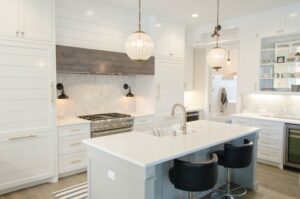While space, place, furniture, and decor get most of the attention when it comes to home improvement and design, an oft-forgotten topic is lighting. However, the truth is that how you light your house or apartment can have a tremendous effect on your mood, happiness, and how you use the various rooms in your home.
That’s why in this series, we’re discussing different considerations for how to light all the different rooms in the house. In this article, we’re looking at what is arguably the most important room in any house: the kitchen! (And if you haven’t read part 1, feel free to jump over there first and get some tips on how to light your living room.)
Functionality and proper lighting in the kitchen
A scary truth is that the kitchen is the room in the home where accidents are most likely to happen. However, that doesn’t mean you need to be afraid – you just need to be prudent. It’s definitely an invitation to think long and hard about how best to light your kitchen.
If your kitchen and living room are combined, feel free to mix and match the tips we’ve already discussed in part 1 with the ones to follow here. That said, you’ll definitely find that task lighting comes into its own here. (As a reminder, “task lighting” is specific lighting for a task, such as a lamp on a nightstand by your bedside so you can read a book, whereas “ambient lighting” is a broad, usually overhead light that illuminates the entire room. Finally, “accent lighting” is just what it sounds like: specific decorative lighting choices that accent, or highlight parts of a room.)
Many of us are lucky enough to have kitchens that face big windows that let in plenty of sunlight. Yet whether that’s true of your kitchen or not, what’s important is making sure there’s always a consistent level of light to work with, whatever the season or weather outside. Oftentimes, you’ll find the main ambient lights of the kitchen have powerful bulbs in, which shed a lot of light to all corners of the room.
However, if you’re finding it tricky working in your kitchen – from preparing meals to washing up – it might be that you’re in need of more task lighting.
Naturally, few of us really can get behind the idea of bringing a standing lamp or desk lamp into our kitchen to light up the cutting board, chase away shadows from the sink or illuminate pots and pans on the stovetop.
Instead, consider an almost spotlight-like approach over areas where you know you’re going to be busy and focused in the kitchen. Task lighting above your oven hobs, the sink where you do the dishes or the cutting board or blender where you dice up ingredients is a key step towards better kitchen safety.
Wall based lamps can work wonders here, or lights embedded beneath overhead cupboards or the hood of your stove. They can be simple adhesive touch lights too, if you’re not comfortable with drilling into and embedding lighting into your kitchen fixtures.
What matters most is that you’ve always got a clear line of sight for everything in the kitchen. That means key focal points of light where more intensive busywork gets undertaken, but also a decent level of ambient lighting for the room as a whole.
More lighting tips for your kitchen
Have some gorgeous paintings or artwork in your kitchen you’d like to give a soft glow too? Hey, it doesn’t all have to be functional lighting in here – get some soft accent lights on the walls for those features! Remember to have fun with it, and give your kitchen the same personality and theme you give the rest of your home.
Now that you’ve lit up your kitchen to make some delicious food, in the next installment of this series, we’re going to look at the lighting in the dining room.
In the mean time, however, come check out our massive New Jersey furniture showroom to see all of the furniture and decor options we have at Fireside Furniture, on Route 23 in Pompton Plains, NJ.
